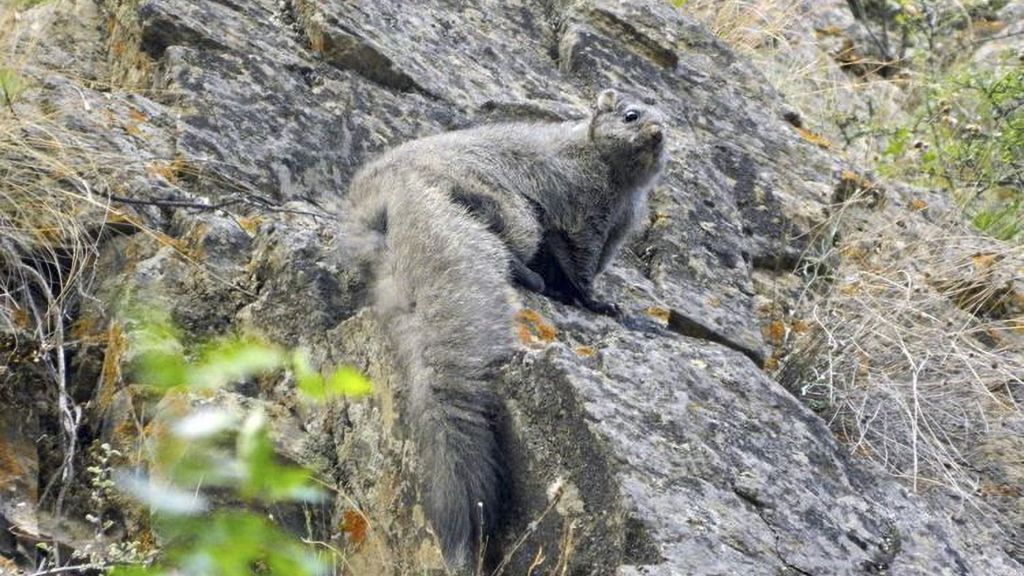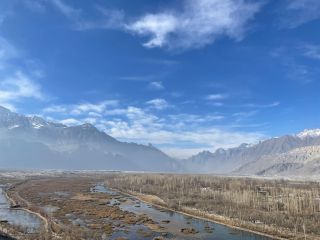Pakistan has a dry climate with high mountains in the north and warmer areas in the south. While the mountain sides in the north are covered with forest, other parts of Pakistan are characterized by grass and shrubs, with few and scattered trees. In the west, plants are adapted to the dry climate, while the desert area has very few plants. Along the coast in the south we can find mangrove forest.
When it comes to animals, Pakistan is on the border between the Oriental and the Palaearctic region. The country has over 150 mammal species, over 174 reptile species , over 730 kinds of birds and 16 amphibian species.
In the mountains in the north we can find: bharal, Eurasian Lynx, Himalayan goral, golden marmot, yellow-throated marten, ladakh pikka, flying squirrels, red fox and others. There are several threatened species such as the Marco Polo sheep of which there are very few left, wooly flying squirrel, snow leopard, Indian wolf, Himalayan brown bear, white-bellied musk deer, rhesus macaque, markhor, Siberian ibex and others.
In the Indus and Sindh deserts we find wild boars, red fox, axis deer, hog deer, dhole, Indian pangolin, Punjab urial, Sindh Ibex and many others. Towards the west we can find porcupine, gazelle, leopards, markhors, honey badger, striped hyena and others.
Towards the coast and in the wetlands and mangroves there are many animals such as river dolphins, fishing cat, leopard cat.
Besides mammals, the country of course has a very large variety of birds and also marine mammals, reptiles and amphibians. Many of its animals are endangered as the result of years of poaching and hunting without respecting any quotas.
Below we’ll talk briefly about a few of the most iconic animals in Pakistan.
Indian Leopard
The Indian leopard lives in the area around the Indian subcontinent, including India, Nepal, Bhutan, Bangladesh, China and Pakistan. Here it mainly lives in the deciduous and coniferous forests of northern Pakistan. Topographic barriers such as the Himalayas to the north or the Indus River to the west have prevented the dispersal of this subspecies, leaving it isolated from other leopard populations. To the east, the Ganges delta has similarly separated the Indian leopard from the Indochinese leopard. The leopard is a nocturnal animal and hunts at night. Due to the loss of habitat and food, the International Union for Conservation of Nature (IUCN) has classified the common leopard as ‘critically endangered’. According to WWF, the biggest threats to this leopard are increased contact with humans, hunting for illegal trade and habitat loss. The WWF also indicates that leopards in this area are killed by car accidents. Over the years, many leopards have been poisoned, shot or forced to relocate. We can find leopards in the Himalayas, Kirthar Mountains, Balochistan, Murree Hills, Machiara NP, Pir Lasora NP, Ayubia NP and Margalla Hills near Islamabad.
Within the Indian leopard, two subspecies would be classified until recently considered within the Persian leopard, they are the Kashmir leopard (Panthera pardus millardi) and the Nepalese leopard (Panthera pardus pernigra).
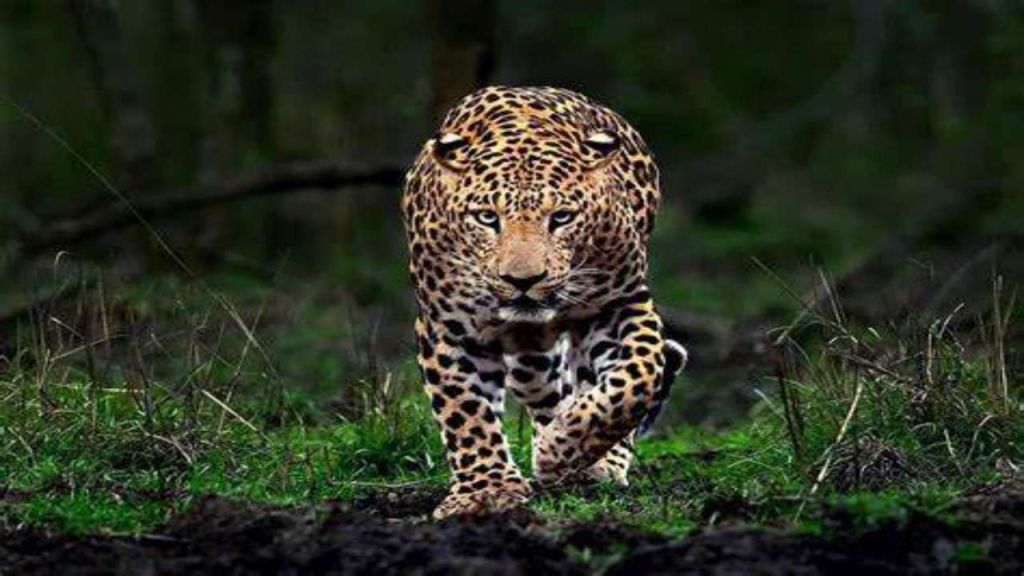
Snow Leopard
This beautiful feline is an animal from the high mountains of Asia that is able to live at high altitudes and withstand the harsh winters thanks to its thick fur. Its cream gray coat with pale yellow and beige patches with a black ring provides excellent camouflage, especially in the snowy undergrowth in winter. Its legs are large with hairy pads as protection against the cold. The Snow Leopard can reach a length of more than 1m20 and also has a long tail of 1m that helps to keep its balance when it moves on rocky cliffs to chase its prey. In the summer he hunts mouflons and ibex in the mountains. In winter, its menu consists of wild boars and small animals from the valleys and forests at lower elevations. The snow leopard is very agile and powerful; thanks to his spring-shaped muscles, he can make huge jumps.
The female gives birth to up to 4 to 5 cubs which she raises in a den, usually a well-protected rock shelter. This beautiful animal is seriously endangered due to hunting for its fur. There are currently between 4,000 and 7,000 snow leopards in the wild of which there are around 400 or so living in northern Pakistan in Gilgit-Baltistan. The number of animals continues to fall because the animals are hunted for their fur and bones and because there is less prey. Leopards are also being poisoned by villagers who protect their livestock from being killed by snow leopards. Educational programmes are very important to raise awareness as well as funding for herders to protect their cattle. Unfortunately funding has reduced enormously during the last few years.
We at Tours To Pakistan offer three kinds of wildlife tours in the north of Pakistan with a very high chance to see snow leopards and this with the leading snow leopard experts in Pakistan. A part of what you’ll be paying for your snow leopard tour in Pakistan will be going to educational programmes which are run by our team in the neighborhood: at the local community and the local schools to raise awareness and to find solutions on how to work together in preserving snow leopards in Pakistan. So, know that if you choose to work with us, you’ll be contributing to these local projects.
Pakistan is not really known for its snow leopards and because of the small population, people often opt for other countries. Our experts are the only ones in Pakistan who have been actively tracking snow leopards for almost 40 years. They know the trails, the spots where they mark their territories and you have a really high chance of seeing snow leopards if you stay 7 to 10 days. Some people even see them within two or three days and we have had one occasion with Japanese tourists where six animals were spotted over three different occasions and all within one day. (although we need to admit this is highly exceptional!)
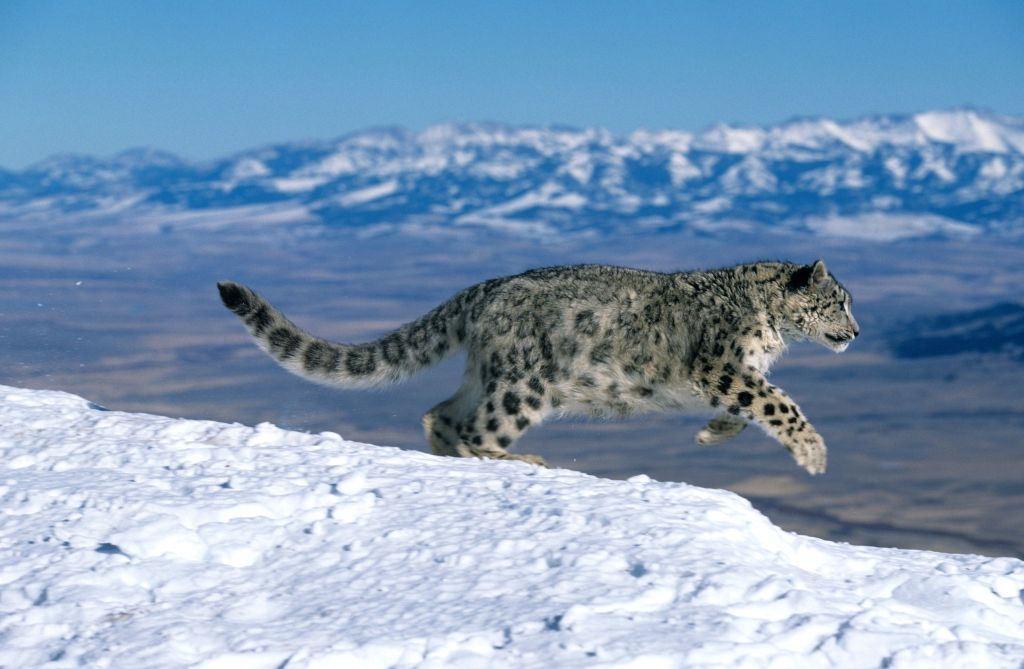
Markhor
The markhor is the national symbol of Pakistan and has a grayish reddish brown coat, which becomes lighter with age. Old animals have an almost white fur. The winter coat is longer and grayer than the shorter, redder summer coat. The shape and length of the horn varies by place and individual. In Kashmir, the horns can be up to 165 centimeters long, but usually the horns of the buck are 82 to 143 centimeters long. In females, the horns become much smaller, up to 25 centimeters in length. The buck has a long mane on the neck, chest and shins and a long goatee.
The markhor grows to 140 to 180 centimeters long, the tail becomes 8 to 14 centimeters long. The buck has a height of 86 to 115 centimeters, a head-torso length of 162 to 180 centimeters and a body weight of 80 to 120 kilograms. The female becomes much smaller, 140 to 150 centimeters long, 65 to 70 centimeters high and 32 to 40 kilograms.
The markhor mainly inhabits steep, rocky, forested slopes and canyons in the western Himalayas, in southern Uzbekistan, Tajikistan, Afghanistan, northern Pakistan, Kashmir and northern India. They are found at an altitude of between 700 and 4000 meters. In summer it occurs mainly up to an altitude of 3000 to 3500 meters. It is an excellent climber.
The markhor lives on grass, leaves, herbs and twigs. In winter, the diet consists mainly of moss, twigs and buds of shrubs. To reach higher vegetation, they sometimes raise themselves on their hind legs. They are mainly active at dusk. The main enemies are snow leopards, wolves and lynxes. The markhor lives in small herds of an average of nine animals, consisting of a few females and their young. Bucks usually live solitary.
Markhor are often attacked by snow leopards who follow them and you have the possibility of seeing markhor during our snow leopard tours in the north of Pakistan.
Siberian Ibex
The Siberian ibex is the tallest and heaviest representative of the genus Capra (ibex and goats), although the markhor has a greater shoulder height. It is an iconic animal in the northern mountain regions of Pakistan and you have a great chance of spotting it during our snow leopard tracking safari in Gilgit-Baltistan.
The Siberian ibex lives on the mountain sides and mountain pastures of the Himalaya, Tibet, Karakoram, Pamir, Hindu Kush, Tienshan and Altai mountains. In addition, a population has been released in the Florida Mountains in the US. The natural habitat is well above the tree line in summer, sometimes up to the vegetation line. Even in snowfall, Siberian ibex can still find food by scraping the snow away with their feet. In winter, the animals descend to the lower slopes in search of food.
The size can vary greatly, with shoulder heights between 67-110 cm, lengths of 130-165 cm and a weight between 35-130 kg. The females are clearly smaller than the males. The coat color is normally a light brown sheen, darker in winter than in summer. Older males take on a darker color, with light spots. Both sexes have goatees and horns. In the females, the horns remain relatively small (up to 35 cm long); in the males they can grow up to 130 cm long.
The females and young usually live in groups of 10 to 20 animals. Young males also form groups, while older males often live solitary. In groups, a strict order of rank is maintained, which is why fighting is done using the horns. Normally, the males and females only live mixed during the rutting season, but some mixed groups have been observed in the Himalayas that stay together all year round. The Siberian ibex feeds on grasses and herbs. The animals are mainly active during the day.
Pregnancy lasts 5 to 6 months in the Siberian ibex. Usually a single young is born, but litters of two or three also occur. The young are sexually mature between one and a half and two years. Siberian ibex can live up to 17 years. The natural enemies are wolves, snow leopards and brown bears. Young animals can also fall prey to smaller predators, such as eagles, lynx or foxes. As they are frequent in parks such as Khunjerab National Park, you’re going to see ibex during your snow leopard spotting safari in northern Pakistan if you book a snow leopard tour with Tours To Pakistan.
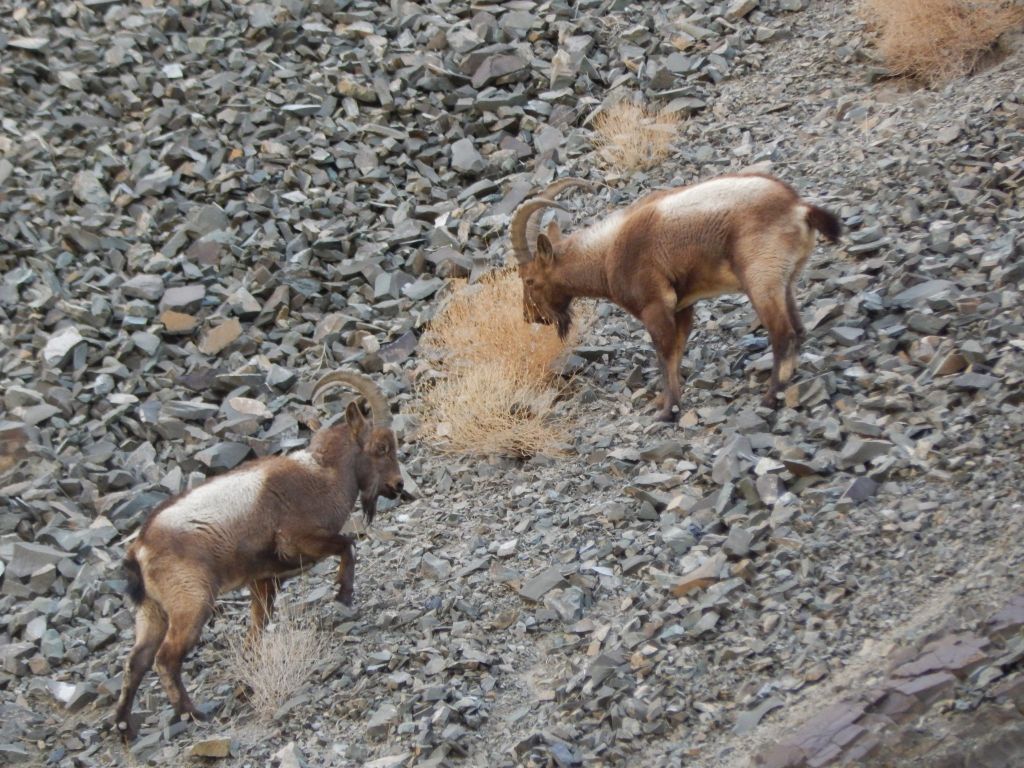
Himalayan Brown Bear
The Himalayan bear is a subspecies of the brown bear. Its fur is reddish-brown or sandy in color. It lives in the foothills of the Himalayas at altitudes of up to 4900 meters and in northern Pakistan and Kashmir. Genetic studies confirm that these Central Asian brown bears differ significantly from other species. The bears of the Gobi desert, sometimes referred to as Gobi bears, represent a relict population of the brown bear according to these analyses. The number of wild animals is unknown due to their rarity. Around 35 animals live in the Deosai National Park. International trade in these animals is banned by local conservation authorities.
The brown bear is thought to be the trigger for the Yeti mythology because, like other brown bears, it occasionally stands up on its hind legs when foraging for food, making it appear larger and more “human.” The male is 1.5 to 2.2 meters long, while the female reaches a size between 1.37 and 1.83 m. Between October and April/May the bears are in hibernation, which they spend in caves they have built themselves.
The Himalayan brown bear is an omnivore, feeding primarily on grasses, roots and other plants, as well as insects and small mammals. But larger mammals such as sheep or goats are also part of its diet. Adults eat mostly before sunrise and in the late afternoon.
We at Tours To Pakistan offer a tour to Deosai National Park to track bears between the end of May until the end of October, before they go into hibernation. If we are lucky we can see them within 3 or 4 days, but it’s safer to stay up to one week. You will also have the chance to see golden marmot, Himalayan Ibex, red fox, golden eagle and we can even go snow leopard tracking on your wildlife safari in Pakistan.
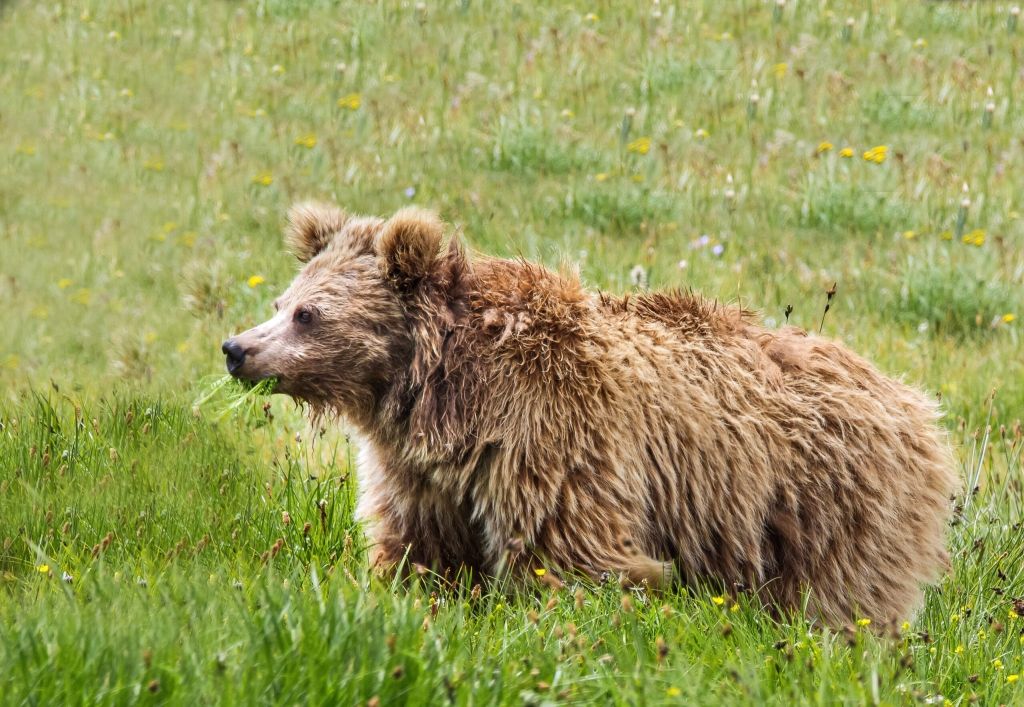
Woolly Flying Squirrel
The woolly flying squirrel is a little known rodent which lives in the Himalayas and Tibetan Plateau. Their territory is shrinking and due to their difficult to reach habitat it is hard to spot them and study them. In northern Pakistan and north-west India we find the western woolly flying squirrel (E. cinereus). There is also the Tibetan woolly flying squirrel (E. tibetensis) and the Yunnan woolly flying squirrel (E. nivamons). Their teeth differ from other squirrels and they are larger than other flying squirrels, it is the heaviest gliding mammal among animals.
The woolly flying squirrel can be found in the Diamer-District in the north of Pakistan. Their habitat is declining since the region around Gilgit is quickly growing and therefore it’s listed as endangered by the IUCN. It lives in pines and junipers between 2.400 m and 3.800 m above sea level.
We at Tours To Pakistan can help researchers and photographers with their search for the woolly flying squirrel in northern Pakistan and have successfully done this in the past. Note that on one expedition it took us ten days (!!) to photograph, so we need time. The animal is nocturnal, so this makes it very difficult. There are also the giant red flying squirrel and the kashmir flying squirrel, which are also nocturnal, so this makes it extremely difficult to find them.
